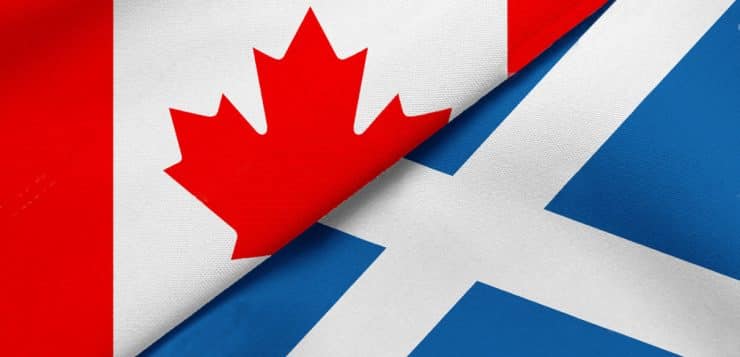There have been times when Canada was regarded as almost an extension of Scotland. And it’s not hard to see why when you realise just how many Scottish place names and family names are to be found throughout Canada; and how many towns, rivers and mountains have been named in honour of Scottish explorers, traders and adventurers – from Mackenzie Bay and Calgary to Nova Scotia (New Scotland) itself.
There have been times when Canada was regarded as almost an extension of Scotland. And it’s not hard to see why when you realise just how many Scottish place names and family names are to be found throughout Canada; and how many towns, rivers and mountains have been named in honour of Scottish explorers, traders and adventurers – from Mackenzie Bay and Calgary to Nova Scotia (New Scotland) itself.
A HOME FROM HOME
Whether they came willingly to make their fortunes, or to escape the Highland Clearances, the early Scots left an indelible imprint on Canada. Among the most celebrated were Lanark-born James Douglas, the ‘Father of BC’, who helped develop a remote trading post on Vancouver Island into the province of British Columbia; Glasgow-born John A Macdonald, Canada’s first Prime Minister, Alexander Mackenzie, the first man to find a route from the east to the west coast; entrepreneurs like Donald Alexander Smith from Forres, the driving force behind The Canadian Pacific Railway, linking Montreal with Vancouver, the Atlantic with the Pacific; and Robert Dunsmuir, an Ayrshire coal miner eventually charged with building the Vancouver Island rail link, making him British Columbia’s first millionaire.
Less well known, but no less extraordinary were the Scots cattlemen and drovers who turned cowboys: cattle barons like Murdo MacKenzie and John Clay who had a hand in firms such as the Prairie Land & Cattle Company (based in Edinburgh) and the Matador Land and Cattle Company (based in Dundee). There were others too, more famous for recording history than making it: Scots like Dollar born James Anderson, ‘The Bard of Barkerville’, and poet Robert Service, who together captured the spirit, characters and legends of the Gold Rush.
This ancestral legacy of the early Scottish emigrants on the development of Canada meant that before 1971, Canadians of Scottish descent were listed as a separate category from the British. In the 1960’s, they were the third largest ethnic group in the country, after the English and French.
FLYING THE FLAG
Today, the enormous contribution that these, and other, Scots made to the development of Canada is celebrated at The Centre for Scottish Studies at Simon Fraser University (SFU), itself named after the Scottish explorer/fur trader who opened up the West of Canada.
Founded in 1999, the Centre provides a focal point for anyone interested in exploring Scottish history and culture as well as the impact of Scots on other cultures and nations, especially Canada. It encourages the inclusion of Scottish themes and subject matter in academic courses, sponsors major conferences, supports a visiting speaker programme and works closely with individuals and groups in the community. This work complements other well‰ÛÒestablished academic programs in Scottish, Celtic or Irish Studies at several universities in Eastern Canada.
Academic activities aside, what SFU is best known for, particularly in Scotland, is its award-winning pipe band. A regular attendee at the World Pipe Band Championships held each year on Glasgow Green, the Canadian contingent has taken the title no less than six times.
A SCOTTISH DIARY
When it’s not competing, the SFU Pipe Band celebrates its Scottish links in other ways. Every January 25th, it leads a parade in honour of Scotland’s national bard. Burns, as you’d expect, has no shortage of Canadian devotees. Chief among them is the Vancouver Burns Fellowship, which was instrumental in erecting a statue of their hero in Stanley Park, a statue cast from the original moulds used for the Burns statue in Ayr. A great bringer together of men, it’s fitting that Burns is involved in Vancouver’s Chinese New Year celebrations. Each year, Gung Haggis Fat Choy sees Chinese men donning kilts and Scots tucking into haggis wonton.
The Bard’s birthday may be the highlight of the Scottish calendar, but it’s not the only entry. Every performers from all over the Scotland, as well as the rest of the Celtic world perform in Nova Scotia’s Celtic Colours International Festival of music and song.
THE TARTAN TRAIL
In the east, situated in the heart of the earliest Scottish settlement of Baddeck in Cape Breton, Nova Scotia, the Gaelic College was founded in 1938 by Rev A.W.R. MacKenzie and began as a school of Gaelic language, Celtic arts and culture in a small log cabin overlooking St. Ann’s Bay. Nowadays, the College has gained an international reputation for its contribution to the maintenance and preservation of the Gaelic language and culture. The only institution of its kind in North America, students learn fiddling, bagpiping, Gaelic and Highland Dancing, and summer festivals attract people of all backgrounds.
Baddeck is also home to the Alexander Graham Bell National Historical Site which currently houses the world’s largest collection of artefacts and archives belonging to the Edinburgh-born inventor, widely regarded as one of the most important figures of the 19th century. Bell’s family decided to emigrate to Canada after Alexander’s two brothers died of tuberculosis. The Baddeck estate, where Bell settled in his later years, was a source of great inspiration for Bell and many of his discoveries took place there.
There are many St Andrew’s and Caledonia Societies based in cities across Canada, with Traditional Highland Games held throughout the country, and cabers tossed as far apart as British Columbia and Nova Scotia! In May of every second year, competitors and visitors from Scotland, the USA, and across Canada descend on Vancouver for a competitive festival of Gaelic music, drama and song.
The list is endless. We could for instance mention Canada’s thriving curling scene; the Celtic musical influence in Cape Breton and the Wild West; the Scottish contribution to Canadian literature; The Scottish Fiddle Orchestra’s outstanding summer tour of Canada; the herd of Ayrshire cattle at the heart of British Columbia’s dairy industry or that other thing we share in common, lake monsters. Scotland may have Nessie, but British Columbia has Ogopogo.
The British Columbia region even has its own Tartan Army. Established in 1998, the Vancouver Tartan Army gather to watch the Scotland games and enjoy a few beers. Others have gone further in pursuit of the beautiful game with Canadian footballers having crossed the Atlantic in recent years to play for Hibernian, Hearts and Falkirk respectively.
With a number of scheduled air services between Scottish and Canadian airports, it’s never been easier to discover the Canadian-Scottish connections for yourself and, each year, hundreds of thousands of travellers cross the Atlantic to experience the heritage of the past and the attractions of today offered by Scotland and Canada.
As we hope you have discovered, the relationship between Scotland and Canada has always been as rich as it is diverse. And today, the two countries are continuing to develop this close relationship in many new areas. Long may the Thistle and the Maple Leaf continue growing together, side by side.
Source: Study in Scotland







